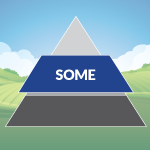Effective Individual and Group Interventions
Schools offer effective group and individual interventions that build students’ skills to manage mental health challenges. The first set of webinars are focused on work with angry and aggressive children and youth. Skill-building is an important component of effective intervention, increasing the likelihood students will be able to cope better, spend more time in class, and build the skills they need to keep moving toward graduation, college and career ready.
Counseling Students Experiencing Anger and Aggression
Students who do not manage their anger, and are aggressive in school are at risk of exclusionary discipline and not graduating. An approach which helps these children and youth learn skills to get along better in school is a proactive approach to a common school problem. The first set of modules provide an overview of the evidence based practice of Cognitive Behavioral Therapy and Interventions. Once these webinars are completed, and reviewed, age-specific training is offered on two evidence-based programs for angry and aggressive students: Anger Coping (grades 4–8) and Think First (high school).
-
Overview of Cognitive Behavioral Therapy and Interventions in Schools
-
Think First: An Evidence-Based Group Intervention for High School Students
Think First: An Evidence-Based Group Intervention for Angry and Aggressive High School Students
|
Module Name
|
Brief Description
|
|
Think First Introduction: Screening, Identification, and Progress Monitoring
|
Become familiar with the goals and training objectives of the Think First program, with the characteristics of students who can and who are unlikely to benefit from Think First intervention, and with direct and indirect methods for identifying participants and monitoring progress.
|
|
Think First: Group Structure and Initial Sessions: Introductions, Choices and Consequences
|
Become familiar with activities to promote group structure, with “housekeeping” options of the group. Find and prepare to use the “Academic Self-Monitoring:
|
|
Think First: Hassle Log and Anger Reducers
|
Become familiar with the Hassle Log, with a definition of anger, with dimensional anger vocabulary, with physiological anger cues, and with palliative anger reducers.
|
|
Think First: Anger Triggers and Attribution Retraining
|
Become familiar with teaching how to understand, describe, and identify one’s own most problematic external anger triggers; with teaching how to understand, describe and identify one’s own most common thought triggers, and with how to differentiate the features of intentional hostility from other intensions.
|
|
Think First: Self-Instruction and Consequential Thinking
|
Become familiar with concepts of self-instruction and their use in anger regulation, and with teaching consequential thinking as a way to avoid unwanted trouble.
|
|
Think First: Social Problem Solving
|
Become familiar with strategies to break down conflicts into solvable problems; with systematic problem solving steps; and with how to help group participants to address at least one major school problem.
|
-
Anger Coping: An Evidence-Based Group Intervention for Upper Elementary and Middle School Students
Anger Coping: An Evidence-Based Group Intervention for Angry and Aggressive Upper Elementary and Middle School Students
|
Module Name
|
Brief Description
|
|
Anger Coping: Screening, Identification and Progress Monitoring
|
Become familiar with the goals and training objectives of the Anger Coping program, with the characteristics of students who can and who are unlikely to benefit from Anger Coping intervention, and with direct and indirect methods for identifying participants and monitoring progress.
|
|
Anger Coping: Group Management and First Sessions
|
Become familiar with activities to promote group structure, with the “housekeeping” options of the group; with strategies for behavior management in the group; with strategies to promote generalization, and with how to teach goal-setting.
|
|
Anger Coping: Middle Sessions
|
Learn strategies to help students change perspectives and understand the thought-feeling connection; learn about the role of anger is social problem solving; learn strategies to help students identify the physiological aspects of anger.
|
|
Anger Coping: Teaching and Practice Problem Solving
|
Learn to teach students to find anger cues; learn strategies to help students generate possible actions and analyze possible consequences; learn strategies to help students use a problem-solving process; learn ways to help students practice; learn strategies to support maintenance and prevent relapse.
|
SBIRT
SBIRT stands for Screening, Brief Intervention, and Referral to Treatment. First developed for alcohol and other drug treatment for adults, it has begun to be used for adolescents as well. It has an evidence base for adults with alcohol and other drug abuse (AODA) issues. SBIRT’s evidence base for use with adolescents with AODA issues is growing. It is now being used as an emerging practice for children and youth with mental health challenges. The Wisconsin Safe and Healthy Schools Center or WISH Center offers training in SBIRT.
Teen Self-Care Planning
What Is a Self-Care Plan and Why?
The Self-Care Plan process and document is designed as a self-discovery tool and conversation starter with youth about their overall well-being. The hope is that youth will feel empowered by the process, which is driven by their ideas, beliefs, and actions. They assess their well-being in eight different areas of their life and consider any new choices they would like to explore as well as the people who can support their choices. The planning process can help youth to understand the importance of balance across the eight areas of well-being.
The Self-Care Plan document is meant to travel with the youth and apply to the various settings of their life. The youth “owns” their plan and can invite caring adults, both personal and professional, to view the plan as a way to increase understanding and effective supports. Self-Care Plans can be used in different settings for a variety of purposes that include one-on-one counseling, group counseling, transition planning between schools or from treatment or corrections placements, after-school programs, youth in foster care, and with youth with emerging MH issues. They can also be used in a classroom that focuses on teen wellness.
